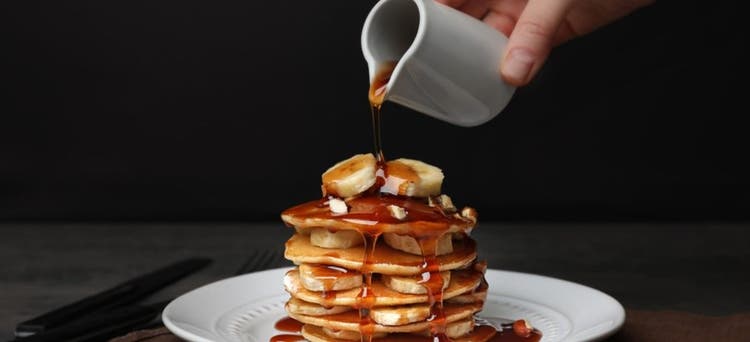
Can Cats and Dogs Eat Maple Syrup?
It’s a bit hard to describe maple syrup to someone unfamiliar with the product. It is deep golden amber in color, has a smooth, silky texture, and a flavor reminiscent of nuts, vanilla, and caramel. What makes it especially difficult to describe is that, according to Agriculture Canada, there are over 90 unique flavors that can be present in maple syrup, depending on the type and age of the tree, when the syrup was harvested, the process used to create the syrup, and various other factors.
Many pet owners wonder about the health and safety of various human foods and ask if products like maple syrup are safe for their pets. In this article, we will consider the possible associated dangers and safest serving methods (if any).
Is Maple Syrup Safe for Pets?
Yes, cats and dogs can eat maple syrup, but it’s certainly not something they need in their daily diets. Pure maple syrup is not toxic or dangerous. The nutritional benefits are fairly minimal, since most syrups are mainly sugar with a trace amount of riboflavin, manganese, zinc, calcium, and amino acids. There is no appreciable fat or protein.
Some dogs like the sweet flavor, but most cats don’t. Cats lack taste bud receptors for sweet foods, but there are still a few that may enjoy the taste.
The Dangers for Cats and Dogs
There are a few potential concerns to keep in mind when feeding maple syrup to pets.
They are:
- Baked goods, pastries, candy, or other human foods may be sweetened with xylitol, which can be deadly for dogs. Small amounts of xylitol can cause life-threatening hypoglycemia (low blood sugar), seizures, and liver failure. Symptoms can begin in as little as 25 minutes or take up to 12 hours. No amount of food sweetened with xylitol should ever be fed to dogs. However, xylitol does not appear to cause the same issues in cats. If your dog ingested any product containing xylitol, call your veterinarian or closest veterinary emergency clinic immediately for their recommendations.
- Pancreatitis or gastrointestinal issues can occur in some pets that aren’t accustomed to eating something unique, sweet, or high in sugar content. Clinical signs include anorexia, drooling (nausea), vomiting, diarrhea, lethargy, and abdominal pain.
- Consistent ingestion of any high calorie food can lead to obesity in pets. Obesity increases the risk of many conditions, including diabetes and a variety of joint problems.
Do Cats and Dogs Need Maple Syrup?
There is nothing in maple syrup required by pets. What dogs and cats do need is a healthy, high-quality pet food, formulated to meet their life-stage needs.
The Safest Way to Feed Maple Syrup to Pets
The safest method is to feed a small drizzle of syrup on a plate or on a few kibbles of high-quality pet food. You could also use it to flavor a treat.
However, there are far better and healthier treats for pets. Though a couple licks of syrup is not necessarily harmful, it is not recommended to feed to pets on a regular basis.
It is critical to ensure that you do not feed maple-flavored pastries or candy sweetened with xylitol or any food cooked with toxic ingredients like raisins, onions, or garlic.
How Much Can You Feed a Pet?
A couple of licks is plenty. It is much healthier to give your dog a nutritional snack, such as fresh and clean green beans, peas, or carrots.
Are Pets Allergic to Maple Syrup?
Cats and dogs can be allergic to anything. Allergies to maple syrup appear to be uncommon, but because it is not a core part of recommended diets, there are many unknowns about the product. More common food allergens are protein-based, specifically chicken, beef, and dairy products. Symptoms of allergies vary from skin problems to gastrointestinal issues and include infections, itching, vomiting, and diarrhea.